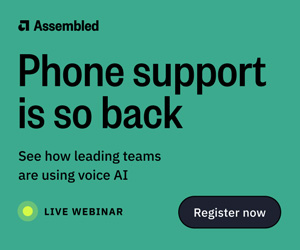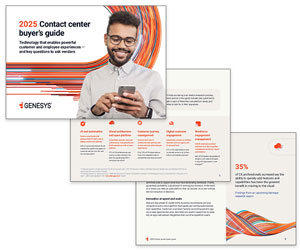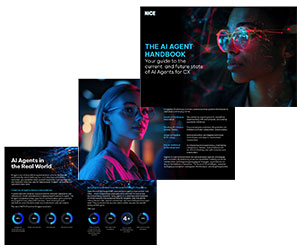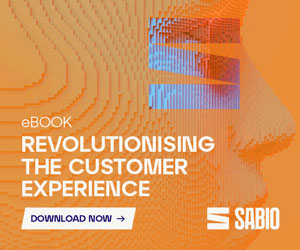Self-service is nothing new, but thanks to the growing capabilities of AI, what’s now possible with these channels has changed significantly.
That’s why we’ve asked our panel of experts “what’s next with self-service?” to hear their thoughts on everything from hyper-personalization and NLP-enabled voicebots, to the expected impact on agent headcount.
Here’s what they said…
1. Standard Responses Will Become a Thing of the Past

Gone are the days of standard responses that do not fully meet users’ expectations, frustrating them and increasing contact rates on other channels.
Generating a response on the fly, considering context and company information, will now be within reach across all channels.
Self-service will not only be functional but enter a conversational era, with questions and answers driving more advanced analytics.
This deeper customer understanding will enable companies to make in-the-moment personalized offers that capture opportunities, improve journeys and increase lifetime value.
Contributed by: Nicolas Marcoin, Product Marketing Manager, Odigo
2. Customers Will See a More Sophisticated Menu of Options
AI-enabled speech capabilities allow a more sophisticated menu of options and speeds up response times, which provides a better outcome for customers while reducing the operational load on human agents.
By handling routine enquiries autonomously, voicebots allow human agents to focus on more complex and sensitive issues.
AI-powered voicebots can also significantly boost satisfaction rates and optimize overall operational efficiency.
Contributed by: Simon Adnett, VP Sales UK&I/MEA, Enghouse Interactive
3. Brands Will Be Able to Match Each Customer’s Unique Profile With Business Objectives

Traditionally, self-service interactions have been very one-dimensional and not personalized, but thanks to the introduction of purpose-built AI for CX, that is changing.
When AI is integrated into CX operations, it enables organizations to draw a much more holistic picture of each customer, including their unique context, history and preferences.
Brands can match each customer’s unique profile with business objectives to proactively anticipate customer needs, suggest relevant offers, provide timely reminders or resolve issues before they escalate.
A great application of this is in the travel industry. As self-service becomes more intelligent with AI, consumers can chat with a bot on a travel website to plan their entire vacation at the click of a button.
The bot will have the relevant knowledge about the customer to present a hyper-personalized plan. This is next-generation self-service.
Contributed by: Elizabeth Tobey, Head of Marketing, Digital Solutions, NICE
4. Chatbots Will Be Able to Accurately Interpret Customer Intent
As we advance through 2024, the role of advanced AI and automation in self-service will grow significantly.
Contact centres should closely monitor the evolution of natural language processing (NLP) and machine learning technologies, which enhance the functionality of virtual assistants and chatbots.
These advancements enable more complex interactions, accurately interpreting customer intent and providing precise responses.
Contributed by: Tatiana Polyakova, COO, MiaRec
5. Customers Will Expect Effortless Transitions Between All Channels

Nowadays, and even more so in the future, customers expect to transition effortlessly between chat, email, and even social media – so organizations must ensure their self-service platforms are integrated across all channels, providing a streamlined omnichannel experience every time.
Leaders should start investing in technology that can help contact centres understand customer behaviours and preferences better, to deliver a much more personalized self-service journey.
Those who have already adopted and implemented this type of technology in the early part of 2024, including generative AI, will be reaping the rewards moving forward, and those that haven’t should start their journey sooner rather than later.
Contributed by: Frank Sherlock, VP of International, CallMiner
6. Self-Service Will Limit the Need for Additional Headcount (But Leaders Will Still Need to Manage Their Expectations in the Short Term)

There are lots of promises out there that the use of generative AI in self-service is going to enable contact centres to completely replace their frontline agents, but this is creating tension in the industry – as it’s simply not the case right now.
The actual figures on reported headcount reductions are dramatically different, as the Assisted Service in the Age of AI: Use Technology to Support, Not Replace Reps report shows, “a Gartner survey of 822 business executives from September through November 2023 found that 61% of the surveyed customer service and support leaders expect headcount reductions of 5% or less due to GenAI, even through 2026.”
Not only that, but the report continued to show that, when polled, “most customer service and support leaders indicated the actual benefit of self-service lies in limiting the need for additional headcount. That is, some leaders reported their success in self-service allowed them to keep service headcount flat while their organizations grew, or redeploy their existing headcount to other initiatives or teams.”
This is where expectations really need to be managed across the contact centre industry, as – in the short term at least – it’s more about being able to do more with the employees you have than outright replace people.
Contributed by: Emily Potosky, Senior Director (Research & Advisory) at Gartner
7. Advanced Bots Will Offer Customers a More Natural Communication Experience

AI-powered voicebots represent a transformative leap for contact centre self-service.
Moving past the limitations of traditional IVR systems, these advanced bots offer customers a more natural and rewarding communication experience.
Unlike the traditional IVR, with its manual button-pressing, or even earlier speech-rec models, NLP-enabled voicebots enable fluid engagement, making interactions feel more human and less transactional.
Contributed by: Simon Adnett, VP Sales UK&I/MEA, Enghouse Interactive
8. Contact Centres Will Need a Centralized Knowledge Base – Accessible From Any Channel
The future of self-service is rooted in seamless omnichannel integration and, as customers demand consistent experiences across various touchpoints, establishing a centralized knowledge base accessible from any channel can facilitate this.
9. Personalization Techniques Will Become More Sophisticated

Personalization will play a crucial role in the future of self-service.
AI and machine learning can analyse previous interactions, purchase history, and preferences to deliver personalized responses and recommendations.
For example, a self-service system could recognize a returning customer, offering solutions based on their prior issues or suggesting products and services aligned with their preferences.
Personalized self-service not only boosts customer satisfaction but also fosters stronger customer relationships.
Implementing these strategies necessitates robust data management and privacy considerations to maintain customer trust.
As personalization techniques become more sophisticated, they will become a key differentiator for contact centres aiming to deliver exceptional customer experiences.
10. Self-Service Systems Will Effortlessly Transition to Live Agents When Needed
Self-service systems should effortlessly transition to live agents when needed, carrying over all pertinent context to prevent customers from having to repeat themselves.
Prioritizing omnichannel integration allows contact centers to meet evolving customer expectations, ensuring a smoother and more satisfactory interaction experience.
Contributed by: Tatiana Polyakova, COO, MiaRec
For more great insights and advice from our panel of experts, read these articles next:
- How to Stop Call Transfers Ruining Your CX
- 10 Ways to Kick-Start Your Adherence Improvement Strategy
- Move Over Omnichannel… Intelligent Omnichannel Is Here!
Author: Robyn Coppell
Reviewed by: Xander Freeman
Published On: 22nd Jul 2024 - Last modified: 24th Jul 2024
Read more about - Technology, Artificial Intelligence, CallMiner, Chatbots, CX, Elizabeth Tobey, Emily Potosky, Enghouse Interactive, Frank Sherlock, MiaRec, NICE, Nicolas Marcoin, Odigo, Omnichannel, Self Service, Simon Adnett, Tatiana Polyakova, Top Story









































